Macs2 操作手册与介绍
Mac电脑快捷操作指南

Mac电脑快捷操作指南在日常使用电脑的过程中,了解一些常用的快捷操作能够提高工作效率并简化操作流程。
本文将介绍一些常见的Mac电脑快捷操作,帮助用户更加方便地使用Mac电脑。
1.桌面操作在桌面操作中,使用一些快捷键可以更快地完成一些常见任务。
- 从一个应用程序切换到另一个应用程序:Command + Tab。
- 在应用程序之间打开快速查看:Command + Tab,然后在按住Command键的同时按下Option键。
- 显示桌面:F11键。
- 显示所有窗口:F3键。
- 快速调整窗口大小:按住Option键,将鼠标指针移动到窗口的边缘并拖动。
2.文件和文件夹操作快捷操作也可以在文件和文件夹操作中提供帮助。
- 快速打开Finder:Command + 空格。
- 新建文件夹:Command + Shift + N。
- 快速查看文件和文件夹的详细信息:选中文件或文件夹,按下Command + I。
- 复制文件或文件夹:选中文件或文件夹,按下Command + C。
- 粘贴文件或文件夹:进入目标文件夹,按下Command + V。
3.文本编辑操作在文本编辑中,使用一些快捷键可以提高输入和编辑的效率。
- 在文本中移动光标:- 向左移动一个字符:Ctrl + B。
- 向右移动一个字符:Ctrl + F。
- 移动到当前行的开头:Ctrl + A。
- 移动到当前行的末尾:Ctrl + E。
- 移动到下一个单词的开头:Option + 向右箭头键。
- 移动到上一个单词的开头:Option + 向左箭头键。
- 复制、剪切和粘贴文本:- 选中文本后复制:Command + C。
- 选中文本后剪切:Command + X。
- 粘贴文本:Command + V。
- 撤销和重做操作:- 撤销:Command + Z。
- 重做:Command + Shift + Z。
- 文本大小写转换:选中文本,按下Control + K,然后按下Control + Shift + R。
这可能是最棒的MACS2使用说明
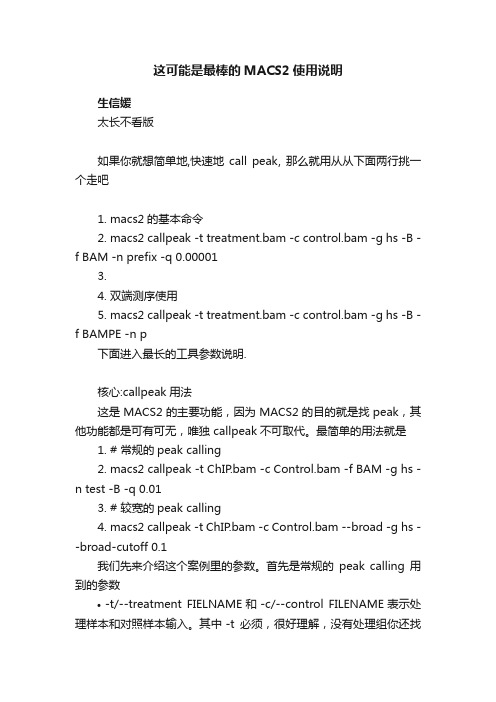
这可能是最棒的MACS2使用说明生信媛太长不看版如果你就想简单地,快速地call peak, 那么就用从从下面两行挑一个走吧1.macs2的基本命令2.macs2 callpeak -t treatment.bam -c control.bam -g hs -B -f BAM -n prefix -q 0.000013.4.双端测序使用5.macs2 callpeak -t treatment.bam -c control.bam -g hs -B -f BAMPE -n p下面进入最长的工具参数说明.核心:callpeak用法这是MACS2的主要功能,因为MACS2的目的就是找peak,其他功能都是可有可无,唯独 callpeak不可取代。
最简单的用法就是1.# 常规的peak calling2.macs2 callpeak -t ChIP.bam -c Control.bam -f BAM -g hs -n test -B -q 0.013.# 较宽的peak calling4.macs2 callpeak -t ChIP.bam -c Control.bam --broad -g hs --broad-cutoff 0.1我们先来介绍这个案例里的参数。
首先是常规的peak calling用到的参数•-t/--treatment FIELNAME和 -c/--control FILENAME表示处理样本和对照样本输入。
其中 -t必须,很好理解,没有处理组你还找啥Peak。
•-f/--format FORMAT用来声明输入的文件格式,目前MACS能够识别的格式有'ELAND', 'BED', 'ELANDMULTI', 'ELANDEXPORT', 'ELANDMULTIPET' (双端测序), 'SAM', 'BAM', 'BOWTIE', 'BAMPE', 'BEDPE'. 除'BAMPE', 'BEDPE'需要特别声明外,其他格式都可以用 AUTO自动检测。
Macs2 操作手册与介绍
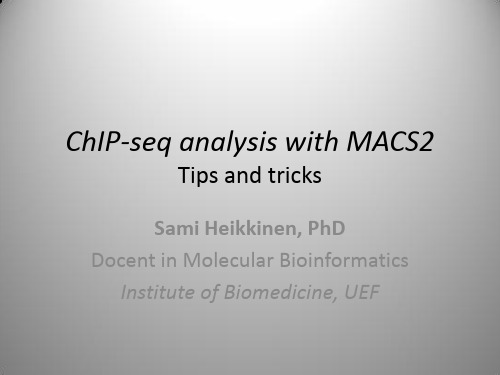
-t/--treatment FILENAME
This is the only REQUIRED parameter for MACS.
Using MACS – connect to server
• Open the SSH client
– at Win –> All programs –> SSH Secure shell –> Secure shell client
the lab of X. Shirley Liu at the Dana-Farber Cancer Institute, Boston
– Genome Biology 2008, 9:R137 – now at version 2.1.0.20140616, developed and maintained by Tao
• Usage tip: use up/down arrow keys to move in command history • ls
– “Quick connect”
• connection : intron.uef.fi • username : <your user ID> • password: <your password>
Hale Waihona Puke Unix 101• pwd
– show Present Working Directory
• cd
– Change Directory – e.g. ‘cd /home/work/public’ to get to the folder we use today (from wherever
you are) – or, to get back to your home directory: ‘cd $HOME’ – or, back one step ‘cd ..’, or two steps ‘cd ../../’
Mac、移动端、平板电脑端用户指南说明书

目录账户注册 (3)手机号码验证 (4)未成年用户 (5)账户登录、预约及支付系统 (6)预约练习 (7)订单与支付 (10)银行卡支付 (11)兑换券支付 (13)准备工作 (15)参加练习 (16)练习变更 (21)取消预约和退款 (24)服务台 (26)账户注册如您尚未注册账户,请登录,进入 SpeakUP 预约及支付门户网站,然后点击“Register”按钮进行账户注册。
请依次填写您的手机号码,设置登录密码并选择您所在的地区及出生日期。
手机号码验证选择您所在的国家代码并输入手机号码,然后点击“Send Code”按钮获取验证码。
此外,您还需要进行安全验证,向右拖动滑块完成拼图。
顺利通过验证后,您会收到系统发送的短信验证码。
请注意,验证码有效时间为2 分钟。
如果您1分钟内未收到短信验证码,可点击“resend”按钮请求重新发送。
未成年用户系统要求账户所有者须年满18周岁,如您未满18周岁,请您的父母或监护人代为注册。
请在正式注册完成前,阅读隐私条款并勾选“I have read and accepted”确认框。
账户登录、预约及支付系统您可以选择以下两种方式进行登录:•手机号+短信验证码•手机号+密码点击下方相应链接切换登录方式(短信验证码或密码)。
如果您忘记登录密码,请点击“Forget Password”按钮,通过手机找回密码。
预约练习在正式预约之前,请先设置您所处的时区。
请选择您要参加练习的时间并预约练习时段。
点击“Book”按钮后,您需要依次输入您本人或未成年用户的全名、出生日期以及第一语言。
如您未满18周岁,出于保护未成年人安全的目的,您还需要输入父母或监护人的联系信息。
XXX全部确认完后,请点击“Next”按钮进行下一步操作。
在用户须知栏内,您可查阅SpeakUP 相关条款细则。
确认信息无误后,请点击“Submit Order”按钮。
XXX订单与支付订单提交成功后,您有30分钟的时间进行付款。
mac 系统使用手册
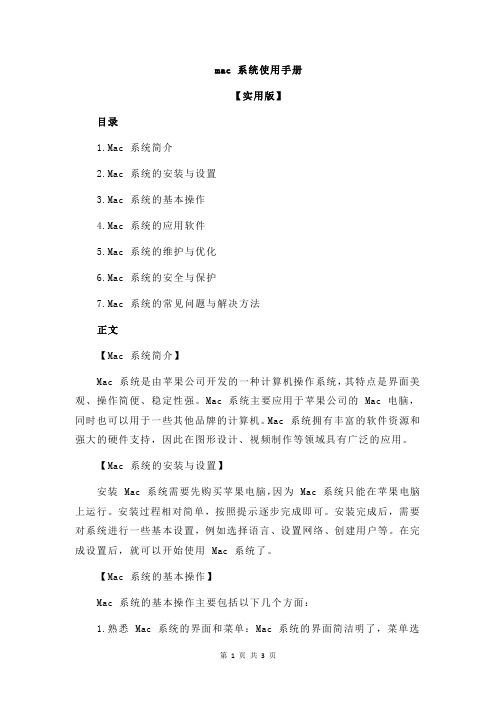
mac 系统使用手册【实用版】目录1.Mac 系统简介2.Mac 系统的安装与设置3.Mac 系统的基本操作4.Mac 系统的应用软件5.Mac 系统的维护与优化6.Mac 系统的安全与保护7.Mac 系统的常见问题与解决方法正文【Mac 系统简介】Mac 系统是由苹果公司开发的一种计算机操作系统,其特点是界面美观、操作简便、稳定性强。
Mac 系统主要应用于苹果公司的 Mac 电脑,同时也可以用于一些其他品牌的计算机。
Mac 系统拥有丰富的软件资源和强大的硬件支持,因此在图形设计、视频制作等领域具有广泛的应用。
【Mac 系统的安装与设置】安装 Mac 系统需要先购买苹果电脑,因为 Mac 系统只能在苹果电脑上运行。
安装过程相对简单,按照提示逐步完成即可。
安装完成后,需要对系统进行一些基本设置,例如选择语言、设置网络、创建用户等。
在完成设置后,就可以开始使用 Mac 系统了。
【Mac 系统的基本操作】Mac 系统的基本操作主要包括以下几个方面:1.熟悉 Mac 系统的界面和菜单:Mac 系统的界面简洁明了,菜单选项也很容易找到。
通过熟悉界面和菜单,可以更快地掌握 Mac 系统的使用方法。
2.使用鼠标和触摸板:Mac 系统支持多种输入设备,包括鼠标、触摸板等。
熟练使用这些设备,可以提高操作效率。
3.掌握基本的快捷键:Mac 系统有很多实用的快捷键,例如复制、粘贴、删除等。
掌握这些快捷键,可以大大提高工作效率。
【Mac 系统的应用软件】Mac 系统拥有丰富的应用软件,包括系统自带的软件和第三方开发的软件。
其中,系统自带的软件包括 Safari 浏览器、Mail 邮件客户端、iMovie 视频编辑软件等。
这些软件可以满足日常办公和娱乐需求。
此外,Mac 系统还有丰富的第三方软件资源,例如 Photoshop、Microsoft Office 等。
用户可以根据自己的需要安装和使用这些软件。
【Mac 系统的维护与优化】为了保持 Mac 系统的稳定性和流畅性,需要定期进行维护和优化。
MAC系统使用指南
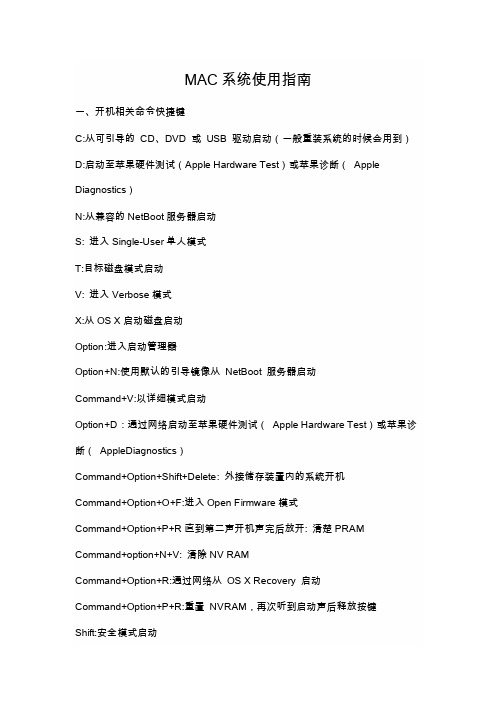
MAC系统使用指南一、开机相关命令快捷键C:从可引导的CD、DVD 或USB 驱动启动(一般重装系统的时候会用到)D:启动至苹果硬件测试(Apple Hardware Test)或苹果诊断(Apple Diagnostics)N:从兼容的NetBoot服务器启动S: 进入Single-User单人模式T:目标磁盘模式启动V: 进入Verbose模式X:从OS X启动磁盘启动Option:进入启动管理器Option+N:使用默认的引导镜像从NetBoot 服务器启动Command+V:以详细模式启动Option+D:通过网络启动至苹果硬件测试(Apple Hardware Test)或苹果诊断(AppleDiagnostics)Command+Option+Shift+Delete: 外接储存装置内的系统开机Command+Option+O+F:进入Open Firmware模式Command+Option+P+R直到第二声开机声完后放开: 清楚PRAM Command+option+N+V: 清除NV RAMCommand+Option+R:通过网络从OS X Recovery 启动Command+Option+P+R:重置NVRAM,再次听到启动声后释放按键Shift:安全模式启动鼠标左键:将光盘强制退出Eject(弹出)或F12 或鼠标或触控板按钮:按住其中的一个按键就可以弹出磁盘驱动器里的任何东西。
二、常用的系统快捷键command M:缩小窗口;command W:关闭窗口;command C:连接服务器;control 单击:鼠标右键;command+H:隐藏窗口;command Q:退出应用程序;commandZ:恢复上一步;commandshift Z:恢复下一步;commandshift Q:前往Finder;commandoption:隐藏(打开)Dock;commandoption W:关闭所有窗口;commandoption M:缩小所有窗口;commandE:退出外接装置;commandshift A:前往应用程序文件夹(在finder时);commandcontrol option 8:全屏幕反显;commandcontrol option 弹出键:关机;commandcontrol 开关键:强制重开机;commandoption 弹出键:电脑休眠;commandoption esc:强制退出应用程序;command+单按标题列:跳到上一页;commanddelete:删除文件;commandoption shift delete:强制清除废纸篓;commandoption D:打开内置字典,单字实时翻译;command.(句号):终止任何进行中的操作;ommanddown:在任何文件上使用,可以直接打开该文件;fndelete:删除光标右边的字;command+esc:启动Front Row窗口操作。
MAC苹果笔记本使用技巧
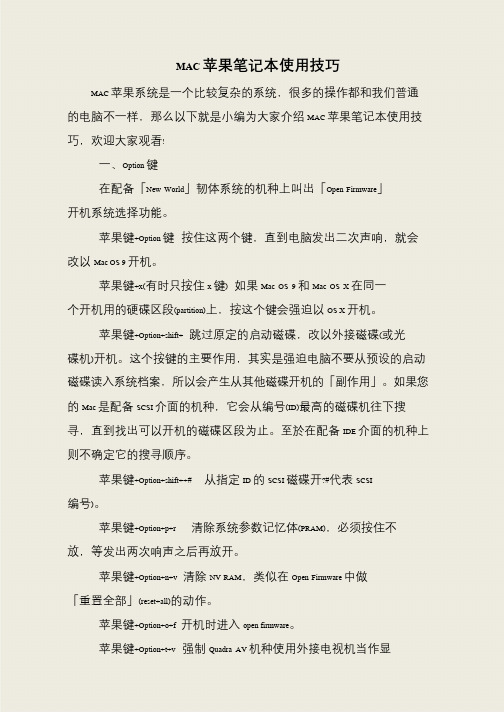
MAC 苹果笔记本使用技巧
MAC 苹果系统是一个比较复杂的系统,很多的操作都和我们普通
的电脑不一样,那么以下就是小编为大家介绍MAC 苹果笔记本使用技巧,欢迎大家观看!
一、Option 键
在配备「New World」韧体系统的机种上叫出「Open Firmware」开机系统选择功能。
苹果键+Option 键按住这两个键,直到电脑发出二次声响,就会改以Mac OS 9 开机。
苹果键+x(有时只按住x 键) 如果Mac OS 9 和Mac OS X 在同一个开机用的硬碟区段(partition)上,按这个键会强迫以OS X 开机。
苹果键+Option+shift+ 跳过原定的启动磁碟,改以外接磁碟(或光碟机)开机。
这个按键的主要作用,其实是强迫电脑不要从预设的启动
磁碟读入系统档案,所以会产生从其他磁碟开机的「副作用」。
如果您
的Mac 是配备SCSI 介面的机种,它会从编号(ID)最高的磁碟机往下搜寻,直到找出可以开机的磁碟区段为止。
至於在配备IDE 介面的机种上则不确定它的搜寻顺序。
苹果键+Option+shift++# 从指定ID 的SCSI 磁碟开?#代表SCSI 编号)。
苹果键+Option+p+r 清除系统参数记忆体(PRAM),必须按住不放,等发出两次响声之后再放开。
苹果键+Option+n+v 清除NV RAM,类似在Open Firmware 中做「重置全部」(reset+all)的动作。
苹果键+Option+o+f 开机时进入open firmware。
苹果键+Option+t+v 强制Quadra AV 机种使用外接电视机当作显。
macs2 bdgdiff原理
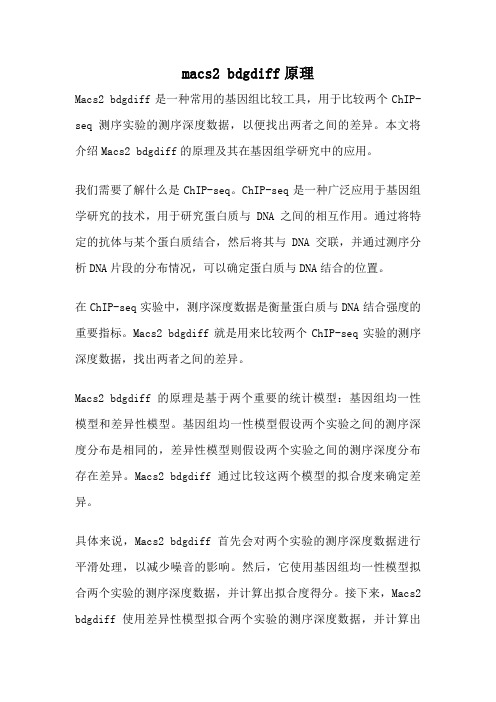
macs2 bdgdiff原理Macs2 bdgdiff是一种常用的基因组比较工具,用于比较两个ChIP-seq测序实验的测序深度数据,以便找出两者之间的差异。
本文将介绍Macs2 bdgdiff的原理及其在基因组学研究中的应用。
我们需要了解什么是ChIP-seq。
ChIP-seq是一种广泛应用于基因组学研究的技术,用于研究蛋白质与DNA之间的相互作用。
通过将特定的抗体与某个蛋白质结合,然后将其与DNA交联,并通过测序分析DNA片段的分布情况,可以确定蛋白质与DNA结合的位置。
在ChIP-seq实验中,测序深度数据是衡量蛋白质与DNA结合强度的重要指标。
Macs2 bdgdiff就是用来比较两个ChIP-seq实验的测序深度数据,找出两者之间的差异。
Macs2 bdgdiff的原理是基于两个重要的统计模型:基因组均一性模型和差异性模型。
基因组均一性模型假设两个实验之间的测序深度分布是相同的,差异性模型则假设两个实验之间的测序深度分布存在差异。
Macs2 bdgdiff通过比较这两个模型的拟合度来确定差异。
具体来说,Macs2 bdgdiff首先会对两个实验的测序深度数据进行平滑处理,以减少噪音的影响。
然后,它使用基因组均一性模型拟合两个实验的测序深度数据,并计算出拟合度得分。
接下来,Macs2 bdgdiff使用差异性模型拟合两个实验的测序深度数据,并计算出拟合度得分。
最后,Macs2 bdgdiff通过比较基因组均一性模型和差异性模型的拟合度得分,确定差异区域。
Macs2 bdgdiff的应用非常广泛。
例如,在研究转录因子结合位点时,可以使用Macs2 bdgdiff来寻找在不同条件下转录因子结合位点的变化。
另外,Macs2 bdgdiff还可以用于寻找在不同组织或细胞类型中基因表达水平的差异。
Macs2 bdgdiff是一种常用的基因组比较工具,可以用于比较两个ChIP-seq实验的测序深度数据,以寻找差异区域。
mac 系统使用手册
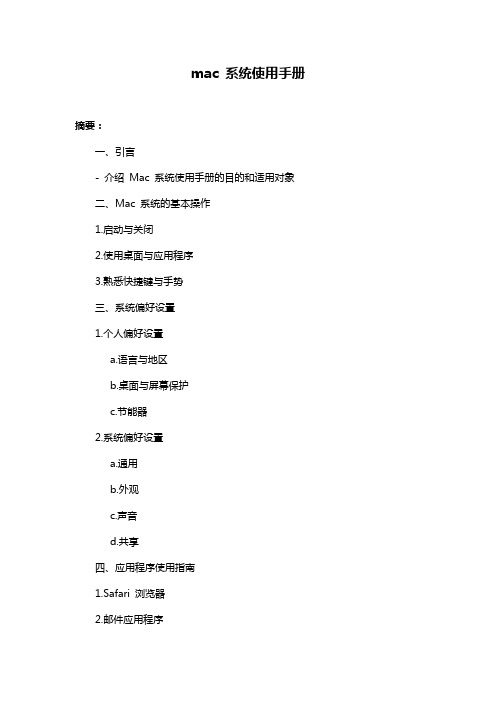
mac 系统使用手册
摘要:
一、引言
- 介绍Mac 系统使用手册的目的和适用对象
二、Mac 系统的基本操作
1.启动与关闭
2.使用桌面与应用程序
3.熟悉快捷键与手势
三、系统偏好设置
1.个人偏好设置
a.语言与地区
b.桌面与屏幕保护
c.节能器
2.系统偏好设置
a.通用
b.外观
c.声音
d.共享
四、应用程序使用指南
1.Safari 浏览器
2.邮件应用程序
3.联系人应用程序
4.日历应用程序
5.备忘录应用程序
五、文件管理
1.浏览文件与文件夹
2.创建、重命名与删除文件与文件夹
3.移动与复制文件与文件夹
4.使用“文稿”文件夹与“桌面”
六、系统维护与优化
1.更新系统与应用程序
2.磁盘管理
3.系统安全
4.性能优化
七、常见问题与解答
1.软件安装与卸载
2.网络连接与设置
3.蓝牙设备配对与使用
4.打印机设置与使用
八、附录
- 产品规格与技术支持信息
正文:
【引言】
Mac 系统使用手册旨在帮助用户更好地了解和充分利用Mac 系统的功能。
本手册适用于所有使用Mac 系统的用户,无论是新手还是有一定经验的用户,都可以在本手册中找到有用的信息。
peak calling with macs2 简书
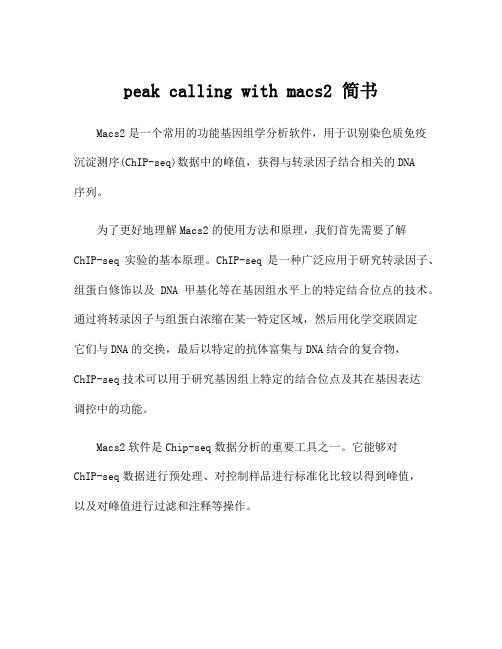
peak calling with macs2 简书Macs2是一个常用的功能基因组学分析软件,用于识别染色质免疫沉淀测序(ChIP-seq)数据中的峰值,获得与转录因子结合相关的DNA序列。
为了更好地理解Macs2的使用方法和原理,我们首先需要了解ChIP-seq实验的基本原理。
ChIP-seq是一种广泛应用于研究转录因子、组蛋白修饰以及DNA甲基化等在基因组水平上的特定结合位点的技术。
通过将转录因子与组蛋白浓缩在某一特定区域,然后用化学交联固定它们与DNA的交换,最后以特定的抗体富集与DNA结合的复合物,ChIP-seq技术可以用于研究基因组上特定的结合位点及其在基因表达调控中的功能。
Macs2软件是Chip-seq数据分析的重要工具之一。
它能够对ChIP-seq数据进行预处理、对控制样品进行标准化比较以得到峰值,以及对峰值进行过滤和注释等操作。
我们首先需要准备好ChIP-seq数据,包括ChIP样品(需要富集转录因子或组蛋白)和对照样品(没有处理的基因组DNA或非特定抗体的样品)。
然后,我们可以使用Macs2来进行如下的数据分析流程:1.数据预处理首先,我们需要处理原始的ChIP-seq测序数据,将其转换为.bam 格式的对齐文件。
针对双端测序,我们可以使用Bowtie2或BWA来将reads映射到参考基因组上,生成对应的sam文件,之后再用samtools将sam文件转换为bam文件。
对于单端测序数据,可以直接使用Bowtie或者BWA进行比对然后转换为bam格式。
2.样品比对和控制比对使用Macs2之前,我们需要对样品以及对照样品进行比对。
这一步主要是为了获得比对后的.bam文件。
3.样品标准化和对照标准化为了可以进行后续的峰值检测,我们需要对样品和对照进行标准化。
标准化的目的在于消除不同样本之间的测序深度差异,以及其他可能导致假阳性的因素。
常见的标准化方法有两种,即基于控制样品的标准化和基于基因组的标准化。
苹果Mac操作系统使用教程(step by step)

Mac使用教程Mac使用教程(基础篇)如果您是计算机新手,或只是需要一些教学课程,帮助您将Mac 的功能发挥到淋漓尽致,那么您就来对地方了。
我们将带领您以最有效率的方式使用Mac。
无论您想知道如何操作使用Mac 桌面(或只是要知道什么是桌面)、找出连接打印机、iPod、数字相机或其他设备的方式、搜寻电子邮件和Internet、认识各种功能的操作方式、学习如何使用Mac 随附的软件,或在无法得心应手地操作时需要协助指点,这种种问题的答案,我们都为您准备好了。
准备好了吗?请把您的问题告诉我们:第一课:Mac 基础操作如果您是初次接触计算机,才刚开始学习各项操作技巧,不用紧张,其实操作Mac 不过就是靠一连串的点选动作。
这一课将为您介绍与计算机界面互动的基本方式,也会教您如何在Mac 上完成一些基本工作。
让我们进入课程内容吧!第一次使用Mac 吗?那就从学习Mac 基础操作开始吧!点点选选轻松操作如果您对Mac 桌面和Finder 视窗的操作不是很熟练,建议您从这里开始学起,如果已经很熟悉了,可以直接跳到“建立帐号”那部分。
我们先来谈谈计算机操作的基本技巧。
移动鼠标时(iBook 或PowerBook 的使用者是以手指在触控式轨迹板上滑动),您会看到有个箭头(即光标)在屏幕上四处游移。
您可以利用这个箭头选取或操作屏幕上的项目,像是选取档案、按下按钮、拖移滑杆等等。
有时候在执行不同的操作或应用程式时,箭头会变成手、十字型、I 型或其他图像。
举例来说,如果您用Safari 来浏览这个网页,并在网页上移动箭头,您会发现,当箭头移到文字或文字栏位(如Google 文字框或URL 栏位)上的时候,它会变成I 型光标(有点像字母"I" 的形状),通常这表示您可以与文字或栏位有所互动(例如输入或拷贝文字)。
当箭头移到按钮或链接上,它会变成手的形状,告诉您这个项目可以点选。
有时候Mac 忙于工作时,箭头会暂时变成旋转中的彩色圆盘(有的Mac 使用者称之为海滩球或风车),这代表某项工作正在执行中。
Mac系统操作说明
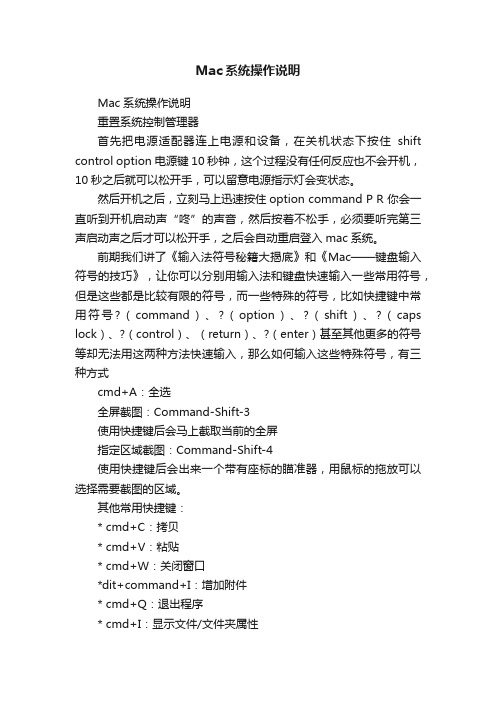
Mac系统操作说明Mac系统操作说明重置系统控制管理器首先把电源适配器连上电源和设备,在关机状态下按住shift control option 电源键10秒钟,这个过程没有任何反应也不会开机,10秒之后就可以松开手,可以留意电源指示灯会变状态。
然后开机之后,立刻马上迅速按住option command P R 你会一直听到开机启动声“咚”的声音,然后按着不松手,必须要听完第三声启动声之后才可以松开手,之后会自动重启登入mac系统。
前期我们讲了《输入法符号秘籍大揭底》和《Mac——键盘输入符号的技巧》,让你可以分别用输入法和键盘快速输入一些常用符号,但是这些都是比较有限的符号,而一些特殊的符号,比如快捷键中常用符号?(command)、?(option)、?(shift)、?(caps lock)、?(control)、(return)、?(enter)甚至其他更多的符号等却无法用这两种方法快速输入,那么如何输入这些特殊符号,有三种方式cmd+A:全选全屏截图:Command-Shift-3使用快捷键后会马上截取当前的全屏指定区域截图:Command-Shift-4使用快捷键后会出来一个带有座标的瞄准器,用鼠标的拖放可以选择需要截图的区域。
其他常用快捷键:* cmd+C:拷贝* cmd+V:粘贴* cmd+W:关闭窗口*dit+command+I:增加附件* cmd+Q:退出程序* cmd+I:显示文件/文件夹属性* cmd+Backspace:删除* cmd+shift+3:捕获整个屏幕* cmd+shift+4:捕获选择的区域* cmd+shift+4+space:捕获某个应用程序的窗口* cmd+F:在应用程序中搜索* cmd+Space:用Spotlight进行桌面搜索* fn+Backspace:相当于Windows里面的Delete键(笔记本键盘专用,台式机键盘有Delete键)* 开机时,听到启动音后,按住Option(相当于Windows的Alt)键,可以选择从Windows或者Mac启动。
Mac系统使用指南从入门到精通

Mac系统使用指南从入门到精通Mac系统是由苹果公司开发的操作系统,它被广泛用于苹果的Mac电脑和其他苹果设备上。
本文将从入门到精通,为您介绍Mac系统的基本操作和高级功能,帮助您更好地使用Mac电脑。
一、Mac系统的基本操作1. 开机与关机Mac电脑的开机与关机非常简单。
按下电源按钮即可开机,点击左上角的Apple菜单,选择“关机”或者按下电源按钮并选择“关机”即可关机。
2. 桌面与底部栏Mac系统的桌面是您操作Mac电脑的主界面,您可以在桌面上放置文件、文件夹和快捷方式。
底部栏是位于桌面底部的工具栏,它包含了许多常用的应用程序图标。
3. 应用程序的打开与关闭点击应用程序图标或通过Spotlight搜索栏,找到并打开您需要的应用程序。
关闭应用程序可点击应用程序窗口左上角的红色关闭按钮,或使用快捷键Command + Q。
4. 文件与文件夹管理您可以使用“Finder”应用程序来管理文件和文件夹。
通过Finder,您可以创建、复制、移动和删除文件和文件夹。
双击文件或文件夹即可打开,右键点击可访问更多选项。
二、Mac系统的高级功能1. 多任务处理Mac系统允许您同时运行多个应用程序,并在不同的窗口中进行操作。
您可以使用Mission Control(三指向上滑动)来查看正在运行的应用程序和窗口,使用分屏功能将多个应用程序并排显示。
2. 快捷键的使用了解和掌握一些Mac系统的常用快捷键,可以大大提高您的工作效率。
例如,Command + C和Command + V分别表示复制和粘贴,Command + S表示保存,Command + Z表示撤销等。
3. 文件备份与恢复Mac系统提供了Time Machine功能,可帮助您定期备份重要文件并在需要时进行恢复。
您可以将外部硬盘或网络存储设备连接到Mac 电脑,然后通过设置开启Time Machine。
4. 终端命令Mac系统使用的是Unix操作系统,您可以通过“终端”应用程序使用命令行界面来执行高级操作。
Mac 操作系统介绍及操作指南大全
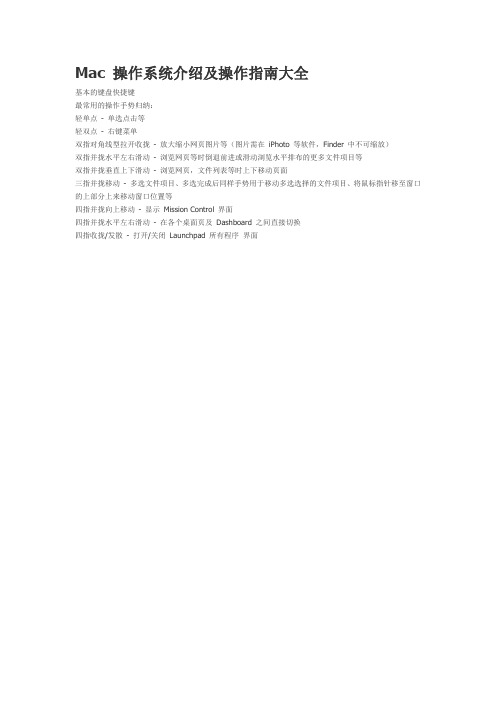
Mac 操作系统介绍及操作指南大全基本的键盘快捷键最常用的操作手势归纳:轻单点- 单选点击等轻双点- 右键菜单双指对角线型拉开收拢- 放大缩小网页图片等(图片需在iPhoto 等软件,Finder 中不可缩放)双指并拢水平左右滑动- 浏览网页等时倒退前进或滑动浏览水平排布的更多文件项目等双指并拢垂直上下滑动- 浏览网页,文件列表等时上下移动页面三指并拢移动- 多选文件项目、多选完成后同样手势用于移动多选选择的文件项目、将鼠标指针移至窗口的上部分上来移动窗口位置等四指并拢向上移动- 显示Mission Control 界面四指并拢水平左右滑动- 在各个桌面页及Dashboard 之间直接切换四指收拢/发散- 打开/关闭Launchpad 所有程序界面基本的键盘快捷键常用必备快捷键归纳:command+tab 快速切换应用程序command+delete 把相关程序中选中的资源移到相关程序废纸篓中shift+command+delete 清倒相关程序的废纸篓command+A 全选command+C 复制command+V 粘贴(需在复制后再粘贴且粘贴不改变原位置的原文件)command+option+V 剪贴(需在复制后再剪贴且剪贴将删除原位置的原文件)command+Space(空格键) 切换输入法command+Q 完全退出当前应用程序(Finder 程序除外)(可配command+tab 功能使用)command+shift+3 全屏截图command+shift+4 选择性截图(可再配合长按空格键进入窗口截图模式)其他参考快捷键归纳:选中要快速预览的文件+空格键快速完整预览选中的各类型文件control+shift+右上角推出/电源键快速锁定计算机command+“+/-”号放大/缩小网页、文本、图片等command+n 新建当前程序的窗口command+w 关闭(非退出)当前窗口command+m 最小化当前窗口到Dock 栏command+option+w 关闭桌面上所以打开的窗口command+option+esc(左上角) 强制退出(如卡死的)当前应用软件control+option+command+(右上角)推出/电源键关机按住option键再拖动文件将文件复制一份后拷贝到新位置,原文件依旧保留在原位置在开机“铛。
iMac 说明书
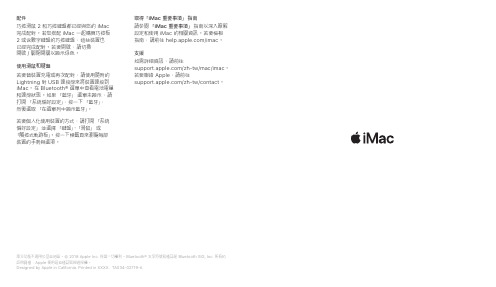
部分功能不適用於某些地區。
© 2018 Apple Inc. 保留一切權利。
Bluetooth® 文字符號和標誌是 Bluetooth SIG, Inc. 所有的註冊商標,Apple 使用這些標誌皆經過授權。
Designed by Apple in California. Printed in XXXX. TA034-02719-A 配件巧控滑鼠 2 和巧控鍵盤都已經與您的 iMac 完成配對。
若您搭配 iMac 一起購買巧控板 2 或含數字鍵盤的巧控鍵盤,這些裝置也已經完成配對。
若要開啟,請切換開啟/關閉開關以顯示綠色。
使用滑鼠和鍵盤 若要替裝置充電或再次配對,請使用隨附的 Lightning 對 USB 連接線來將裝置連接到 iMac 。
在 Bluetooth® 選單中查看電池電量和連線狀態。
如果「藍牙」選單未顯示,請打開「系統偏好設定」,按一下「藍牙」,然後選取「在選單列中顯示藍牙」。
若要個人化使用裝置的方式,請打開「系統偏好設定」並選擇「鍵盤」、「滑鼠」或「觸控式軌跡板」。
按一下標籤頁來瀏覽每部裝置的手勢與選項。
取得 「iMac 重要事項」指南請參閱「iMac 重要事項」指南以深入瞭解設定和使用 iMac 的相關資訊。
若要檢視指南,請前往 /imac 。
支援如需詳細資訊,請前往 /zh-tw/mac/imac 。
若要聯絡 Apple ,請前往/zh-tw/contact 。
歡迎使用 iMac按下電源按鈕來啟動 iMac。
「設定輔助程式」可協助您設定並立即開始使用。
Mac OS系统使用及配置指南
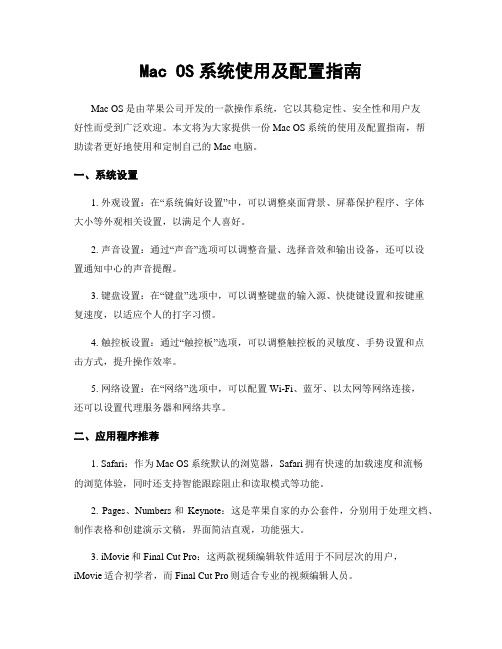
Mac OS系统使用及配置指南Mac OS是由苹果公司开发的一款操作系统,它以其稳定性、安全性和用户友好性而受到广泛欢迎。
本文将为大家提供一份Mac OS系统的使用及配置指南,帮助读者更好地使用和定制自己的Mac电脑。
一、系统设置1. 外观设置:在“系统偏好设置”中,可以调整桌面背景、屏幕保护程序、字体大小等外观相关设置,以满足个人喜好。
2. 声音设置:通过“声音”选项可以调整音量、选择音效和输出设备,还可以设置通知中心的声音提醒。
3. 键盘设置:在“键盘”选项中,可以调整键盘的输入源、快捷键设置和按键重复速度,以适应个人的打字习惯。
4. 触控板设置:通过“触控板”选项,可以调整触控板的灵敏度、手势设置和点击方式,提升操作效率。
5. 网络设置:在“网络”选项中,可以配置Wi-Fi、蓝牙、以太网等网络连接,还可以设置代理服务器和网络共享。
二、应用程序推荐1. Safari:作为Mac OS系统默认的浏览器,Safari拥有快速的加载速度和流畅的浏览体验,同时还支持智能跟踪阻止和读取模式等功能。
2. Pages、Numbers和Keynote:这是苹果自家的办公套件,分别用于处理文档、制作表格和创建演示文稿,界面简洁直观,功能强大。
3. iMovie和Final Cut Pro:这两款视频编辑软件适用于不同层次的用户,iMovie适合初学者,而Final Cut Pro则适合专业的视频编辑人员。
4. GarageBand:这是一款音频编辑软件,可以用于录制和编辑音频,还提供多种乐器和音效,适合音乐爱好者和创作者。
5. Photos:作为Mac OS系统的照片管理应用程序,Photos可以帮助用户整理、编辑和共享照片,还支持人脸识别和智能相册功能。
三、安全与隐私1. 密码管理:使用“钥匙串访问”应用程序可以存储和管理密码,确保密码的安全性和方便性。
2. 防火墙设置:在“安全性与隐私”选项中,可以打开系统自带的防火墙,保护电脑免受网络攻击。
MAC 2.2 2.3 2.4 PROFESSIONAL STEREO AMPLIFIERS说明书
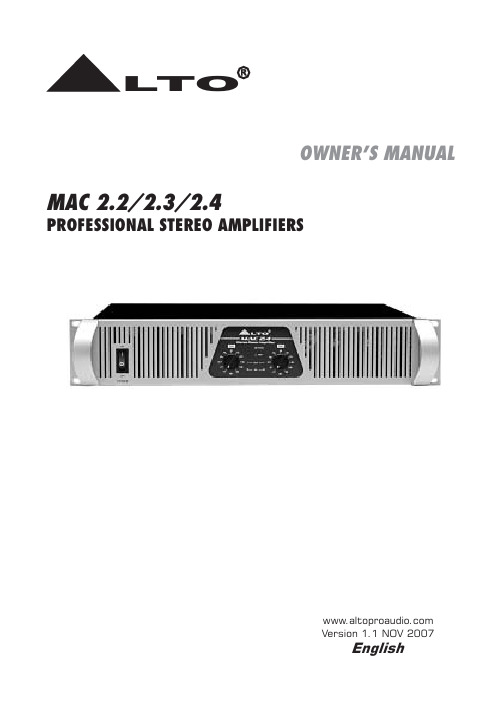
MAC 2.2/2.3/2.4PROFESSIONAL STEREOAMPLIFIERSOWNER'S MANUALVersion 1.1 NOV 2007L TO REnglishIMPORT ANT SAFETY INSTRUCTIONWARNINGT o reduce the risk of electric shockand fire,do not expose this equipmentto moisture or rain.1.2.3.4.5.6.7.8.9.10.Dispose of this product shouldnot be placed in municipal wasteand should be separate collection.11.12.Move this Equipment only with a cart,stand,tripod,orspecified by themanufacturer,orsold with theEquipment.Whena cart is used,usecaution whenmoving the cart/equipmentcombination toavoid possibleinjury from tip-over.Permanent hearing loss may be caused byexposure to\extremely high noise levels.The ernment's Occupational Safetyand Health Administration(OSHA)hasspecified the permissible exposure to noiselevel.These are shown in the following chart:According to OSHA,an exposure to high SPL inexcess of these limits may result in the loss ofheat.T o avoid the potential damage of heat,it isrecommended that Personnel exposed toequipment capable of generating high SPL usehearing protection while such equipment isunder operation.may be sufficient to constitute the risk of electricor death.This symbol,wherever used,alerts you toimportant operating and maintenance instructions.read.Protective Ground T erminalAC mains(Alternating Current)Hazardous Live T erminalON:Denotes the product is turned on.OFF:Denotes the product is turned off.The apparatus shall be connected to a mainssocket outlet with a protective earthingconnection.The mains plug or an appliance coupler is usedas the disconnect device,the disconnect deviceshall remain readily operable.CAUTIONDescribes precautions that should be observed toprevent damage to the product.Read this Manual carefully beforeKeep this Manual in a safe place.Be aware of all warnings reportedwith this symbol.Keep this Equipment away frommoisture.Clean it only with dry cloth.Do not usesolvent or other chemicals.Do not damp or cover any cooling opening.Install the equipment only in accordance withthe Manufacturer's instructions.Power Cords are designed for your safety.Donot remove Ground connections!If the plugdoes not fit your AC outlet,seek advice froma qualified electrician.Protect the powercord and plug from any physical stress toavoid risk of electric shock.Do not placeheavy objects on the power cord.This couldcause electric shock or fire.Unplug this equipment when unused for longperiods of time or during a storm.Refer all service to qualified service personnelonly.Do not perform any servicing other thanthose instructions contained within theUser's Manual.T o prevent fire and damage to the product,use only the recommended fuse type asindicated in this manual.Do not short-circuitthe fuse holder.Before replacing the fuse,make sure that the product is OFF anddisconnected from the AC outlet.HOURS X DAY EXAMPLE864321,510,50,25or lessSPL90929597100102105110115Small gigtrainSubway trainHigh level desktop monitorsClassic music concertRock concertIN THIS MANUAL:1.INTRODUCTION (1)2.FEATURES (1)3.CONTROL ELEMENTS (5)4.OPERATION (8)5.BLOCK DIAGRAM (11)6.TECHNICAL SPECIFICATIONS (12)7.WARRANTY (13)1.INTRODUCTIONL TOThank you for expressing your confidence in products by purchasing one of our MAC2Series stereo amplifiers.The MAC2series include MAC2.2,MAC2.3and MAC2.4.All models are rugged,2rack-unit stereo amplifiers fan-cooled. Despite their compact dimensions they provide a lot of power and a high value performance.They are all designed for heavy-duty application and they all can drive 2ohm loads for long periods without overheating.Therefore they are suited to drive subwoofers with a minimum load of4ohms when working in Bridge Mode.2.FEA TURESClip-limiter circuit that is user-adjustableSwitchable low-frequency filter at30HzOperating Mode is:Stereo,Parallel or BridgeBalanced XLR and1/4"TRS input connectorsOutput connectors are speak-on jacks and binding post terminalsLow-noise,variable speed fanFront panel LED indicating Signal and Clipping and Protection StatusManufactured under QS9000,VDA6.1certified management system12MAC 2.2MAC 2.4MAC2.3One mono signal is input to channel1or Channel2of the MAC2series amplifier and then output to2separate speakers.Each speaker volumecan be set separately.3The Main Mix signal is routed into an electronic crossover.channel1drives the woofer and channel2drives the high frequency driver in a2-way enclosure.45Front Panel:1POWER SWITCHIt powers the MAC 2series ON and OFF .2POWER INDICATOR LEDThis Power LED lights up when the unit is powered up.a.It will light up when the unit is in Protection Mode due to overheating,short circuit,low impedance load or other causes (For MAC 2.2&MAC 2.3).b.It will light up when the unit is in Protection Mode due to overheating,existDC output or other causes (Only for MAC 2.4).3PROTECTIONLED4Clip LEDa.These LEDs will light up when distortion reaches a level of 0.5%,T urn therelative GAIN control down so that the CLIP LEDs only flash occasionally (ForMAC 2series).b.The LED will light up due to short circuit,low impedance load (Only for MAC 2.4).These LEDs will light up when the signal at the output is at least 100mV .5SIGNAL LED6GAIN CONTROLSThese controls are used to adjust the output signal level.7COOLING VENTSThe MAC 2series amplifiers are equipped with two fans,which can accelerate the flow of air to low the temperature inside unit.The inside temperaturedetermines the fan speed,which controls the inside air flowing speed.Rear Panel:8CIRCUIT BREAKERThis is an electronic fuse for protecting the unit from possible damage.When the unit is overloaded or the temperature inside the unit is too high,this push-type button will spring out and disconnect the power supply.Push the Breaker torestore normal working conditions.9IEC socket for AC power cableConnect the supplied main cord.Do not insert the power cord into the MAC2 series amplifier and into the AC Outlet until voltage has been correctly set.10XLR BALANCED INPUT CONNECTORSEach Channel features balanced XLR and1/4"jack sockets wired in parallel.The Balanced signals are less sensitive to hum noise generated by AC.11SPEAKON OUTPUTS(Channel1&Channel2)These connectors are specifically designed to connect high power speakers.The correct polarity is secured automatically,they prevent shock hazard and they lock-in securely.12BINDING POST OUTPUTS(Channel1&Channel2)Please make sure to respect the speaker polarity when using binding post.turn off the unit before connecting an audio signal to the binding post to Caution:avoid any electric shock!613CLIP-LIMITER SWITCHIf a very high level signal is driven into the amplifier,the output signal will"CLIP",that is the peaks of the waveform will be flattered.The Clip Limiter circuit automaticallyreduces the gain to prevent the overdrive.Y ou can switch the Clip Limiter circuitON and OFF via the(13)switch on the rear panel of your MAC2series.If you use full range speakers,the Clip Limiter circuit will reduce the high frequency distortionand it will also protect the high frequency drivers.However,some Users prefer toswitch the Limiter OFF to get more punch from Kick Drums and other sounds inthe low frequencies area.14LOW FREQUENCY FIL TERThis Filter rolls off audio signals below30Hz.In this way bass performance willbe improved,because the subsonic motion of the cone will be cut out and morepower is made available to the woofer in the audible range of frequencies.If youwant our view:Keep the Filter ON most of the time unless you are filtering thesignal before the input of the MAC2series.Especially vented speakers(bass-reflex) are very sensitive to subsonic frequencies(below30Hz).15OUTPUT MODE SELECTORThe MAC2.2/2.3/2.4stereo power amplifier presents three operating modes:-Stereo ModeIn this mode,channel1and channel2operate independently(as a normal stereoamplifier).The channel1input signal will be output from the channel1output connector, and channel2input signal will be output from the channel2output connector.-P arallel Mono ModeIn this mode,channel1input signal will be output from the output connectors ofboth channels.Detail wiring diagram you can refer to chapter4.-Bridged ModeIn this mode,channel1input signal will be output from the bridge-mono outputconnector.Detail wiring diagram you can refer to chapter4.16COOLING FANThis fan secures enough cooling for your MAC2series amplifier.The airflow is front-to-rear.The fan speed is electronically regulated depending on the temperature of the power devices.78In this mode,channel 1and channel 2operate independently (as a conventional stereo amplifier).The channel 1input signal will be output from the channel 1output connectors,and the channel 2input signal will be output from the channel 2output connectors.The MAC 2series amplifiers provide three operating modes:stereo mode,parallel (mono)mode and bridged mode,you can decide each specific operating mode according to your actual application circumstance.Operate MAC 2series in Stereo Mode4.OPERA TIONInput wiring tipsBALANCED UNBALANCEDOperate MAC2series in Parallel ModeIn this mode,the channel1input signal will be output from the output connectors of both channels.The channel2input jack is not used;the channel1and channel2 volumes can be adjusted e the Parallel Mode when you want to drive two speakers with only one input signal keeping separate control of the volume of the two channels.NOTE:since you are not using the channel2input you can use this socket to "daisy-chain"the signal to another amplifier.Input wiring tipsBALANCED UNBALANCED9Operate MAC2series in Bridged ModeIn this mode,the channel1input signal will be output from the bridge output connectors.(The2RED binding post)In this case,use the channel1volume control to adjust the volume,keep the volume control of channel2turned completely down(counter clockwise).Bridged mode is intended for driving loads with a total impedance of4ohms or greater.In Bridge Mode you will combine the power of both channels into one speaker.Y ou will have available massive amount of power so check carefully the power handling of your speaker before operation.Input wiring tipsBALANCED UNBALANCED105.BLOCKDIAGRAM116.TECHNICAL SPECIFICA TIONS12c All rights reserved to AL TO.All features and content might be changed without prior notice.Any photocopy ,translation,or reproduction of part of this manual without written permission is forbidden.Copyright 2007Seikaku GroupSEIKAKU TECHNICAL GROUP LIMITEDNO.1,Lane 17,Sec.2,Han Shi West Road,T aichung 40151,T aiwan T el:886-4-22313737email:*********************Fax:886-4-22346757NF03010-1.0。
- 1、下载文档前请自行甄别文档内容的完整性,平台不提供额外的编辑、内容补充、找答案等附加服务。
- 2、"仅部分预览"的文档,不可在线预览部分如存在完整性等问题,可反馈申请退款(可完整预览的文档不适用该条件!)。
- 3、如文档侵犯您的权益,请联系客服反馈,我们会尽快为您处理(人工客服工作时间:9:00-18:30)。
Using MACS - setup
• cd /home/work/public • mkdir macsout_<user ID>
– <user ID> : e.g. ‘spheikki’ for me – each student MUST have their own folder!!
• to avoid overlapping MACS outputs
ChIP-seq analysis with MACS2
Tips and tricks
Sami Heikkinen, PhD Docent in Molecular Bioinformatics Institute of Biomedicine, UEF
ChIP-Seq simplified
Where?
• checks on seq files
– ls –l seq – head seq/*
• check that macs2 works
– macs2 callpeak
callpeak - Options
Various options to indicate/control input, output, peak modelling and peak calling macs2 callpeak usage: macs2 callpeak [-h] -t TFILE [TFILE ...] [-c [CFILE [CFILE ...]]] [-f {AUTO,BAM,SAM,BED,ELAND,ELANDMULTI,ELANDEXPORT,BOWTIE, BAMPE}] [-g GSIZE] [--keep-dup KEEPDUPLICATES] [--buffer-size BUFFER_SIZE] [--outdir OUTDIR] [-n NAME] [-B] [--verbose VERBOSE] [--trackline] [--SPMR] [-s TSIZE] [--bw BW] [-m MFOLD MFOLD] [--fix-bimodal] [--nomodel] [--shift SHIFT] [--extsize EXTSIZE] [-q QVALUE] [-p PVALUE] [--to-large] [--ratio RATIO] [--down-sample] [--seed SEED] [--nolambda] [--slocal SMALLLOCAL] [--llocal LARGELOCAL] [--broad] [--broad-cutoff BROADCUTOFF] [--call-summits]
36-50 bp
Typically millions of Genetics, 2009
MACS2
• Model-based Analysis of ChIP-Seq • Original version published by Yong Zhang and Tao Liu from the lab of X. Shirley Liu at the Dana-Farber Cancer Institute, Boston
bdgdiff diffpeak
callpeak - Options
Various options to indicate/control input, output, peak modelling and peak calling macs2 callpeak usage: macs2 callpeak [-h] -t TFILE [TFILE ...] [-c [CFILE [CFILE ...]]] [-f {AUTO,BAM,SAM,BED,ELAND,ELANDMULTI,ELANDEXPORT,BOWTIE, BAMPE}] [-g GSIZE] [--keep-dup KEEPDUPLICATES] [--buffer-size BUFFER_SIZE] [--outdir OUTDIR] [-n NAME] [-B] [--verbose VERBOSE] [--trackline] [--SPMR] [-s TSIZE] [--bw BW] [-m MFOLD MFOLD] [--fix-bimodal] [--nomodel] [--shift SHIFT] [--extsize EXTSIZE] [-q QVALUE] [-p PVALUE] [--to-large] [--ratio RATIO] [--down-sample] [--seed SEED] [--nolambda] [--slocal SMALLLOCAL] [--llocal LARGELOCAL] [--broad] [--broad-cutoff BROADCUTOFF] [--call-summits] -t/--treatment FILENAME This is the only REQUIRED parameter for MACS.
Park, Nat Rev Genetics, 2009
Schmidt et al, Methods, 2009
From binding to binding sites
ChIP-seq
~200 bp
Control sample: “Input” or “IgG” - Input: sonicated chromatin without immunoprecipitation - IgG: “unspecific” IP
callpeak – Options - Input
Input files arguments: -t TFILE [TFILE ...], --treatment TFILE [TFILE ...] ChIP-seq treatment file. If multiple files are given as '-t A B C', then they will all be read and combined. REQUIRED. -c [CFILE [CFILE ...]], --control [CFILE [CFILE ...]] Control file. If multiple files are given as '-c A B C', then they will all be read and combined.
– Genome Biology 2008, 9:R137 – now at version 2.1.0.20140616, developed and maintained by Tao Liu at https:///taoliu/MACS/ – https:///taoliu/MACS/blob/macs_v1/README.rst
• Usage tip: use up/down arrow keys to move in command history • ls
– LiSt files in directory – e.g. ‘ls -l’ to show file and folder names AND other info (Long format)
filterdup randsample
callpeak
peaks.xls peaks.narrowPeak OUTPUT FILEs summits.bed model.r model.pdf treat_pileup.bdg control_lambda.bdg
predictd pileup refinepeaks bdgpeakcall bdgbroadcall bdgcmp OUTPUT pileup.bdg refinepeak.bed
Using MACS – connect to server
• Open the SSH client
– at Win –> All programs –> SSH Secure shell –> Secure shell client – “Quick connect”
• connection : intron.uef.fi • username : <your user ID> • password: <your password>
-f {AUTO,BAM,SAM,BED,ELAND,ELANDMULTI,ELANDEXPORT,BOWTIE,BAMPE}, --format {AUTO,BAM,SAM,BED,ELAND,ELANDMULTI,ELANDEXPORT,BOWTIE,BAMPE} Format of tag file, "AUTO", "BED" or "ELAND" or "ELANDMULTI" or "ELANDEXPORT" or "SAM" or "BAM" or "BOWTIE" or "BAMPE". The default AUTO option will let MACS decide which format the file is. Please check the definition in README file if you choose ELAND/ELANDMULTI/ELANDEXPORT/SAM/BAM/BOWTIE. DEFAULT: "AUTO" -g GSIZE, --gsize GSIZE Effective genome size. It can be 1.0e+9 or 1000000000, or shortcuts:'hs' for human (2.7e9), 'mm' for mouse (1.87e9), 'ce' for C. elegans (9e7) and 'dm' for fruitfly (1.2e8), Default:hs --keep-dup KEEPDUPLICATES It controls the MACS behavior towards duplicate tags at the exact same location -- the same coordination and the same strand. The 'auto' option makes MACS calculate the maximum tags at the exact same location based on binomal distribution using 1e-5 as pvalue cutoff; and the 'all' option keeps every tags. If an integer is given, at most this number of tags will be kept at the same location. The default is to keep one tag at the same location. Default: 1 --buffer-size BUFFER_SIZE Buffer size for incrementally increasing internal array size to store reads alignment information. In most cases, you don't have to change this parameter. However, if there are large number of chromosomes/contigs/scaffolds in your alignment, it's recommended to specify a smaller buffer size in order to decrease memory usage (but it will take longer time to read alignment files). Minimum memory requested for reading an alignment file is about # of CHROMOSOME * BUFFER_SIZE * 2 Bytes. DEFAULT: 100000
